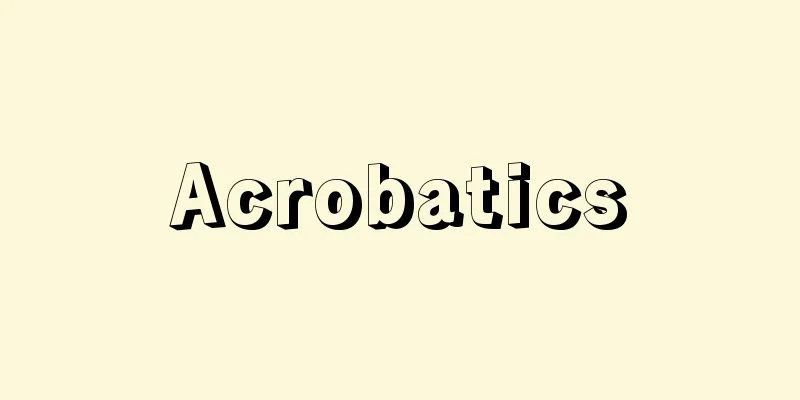Acrobatics

|
It means acrobats and acrobats who perform acrobatic skills, as well as the skilled exercises that they perform, such as flips, ball riding, and swinging. Originally, it meant the Greek word for "walking on the edge," or tightrope walking. It can also refer to acrobatic dance, a dance that aims to show extreme physical flexibility. Acrobatics can be broadly divided into acrobatics that show physical skill and magic tricks and magic tricks that show manual skills. Physical skills can be divided into (1) those that focus on strength, (2) those that focus on flexibility, (3) those that focus on balance, and (4) those that focus on aerial tricks. In the narrow sense, acrobatics fall into the category of those that focus on balance. The art of tightrope walkers, which was famous in ancient Egypt, was introduced to Asia Minor, and is thought to have been introduced from there to Greece and Rome, and then to India via Persia, as well as to the Western Regions, China, and Japan. However, when Cortés arrived in Mexico in 1519, the Aztecs (see Aztec Empire) were known to have performed tightrope walking without a balancing pole in front of idols, as well as various races and fights. This shows that there is only a limited amount that can be said about the spread of the art of tightrope walking. In ancient times, acrobats were mainly women, but from the Middle Ages onwards, men also began to appear on the stage. Pyramid building by guilds at city festivals was a great inspiration for performers. The popularity of acrobat spectacles has not waned up to modern times, and in 18th century France under Louis XIV, a guild of acrobat instructors was even established. Goethe's The Apprenticeship of Wilhelm Meister (see Wilhelm Meister), a great social picture of the time, vividly depicts a group of performers in a marketplace. Modern acrobatics has taken the form of record-breaking challenges for the height of the rope, the degree of inclination, or the duration of the tightrope walk, as a show in circuses and music halls, or as a sporting event in which performers compete under certain conditions. Sports acrobatics include feats of strength and flexibility, and tricks on the floor or in the air, using trapeze traps, ropes, poles, bicycles, rollers, springboards, and other equipment. In 1973, the International Federation of Artistic and Sports was founded in Moscow, and efforts are being made to promote acrobatics, mainly in Germany and Russia. → Related topics Circus | Gymnastics | Music Hall Source : Heibonsha Encyclopedia About MyPedia Information |
|
曲芸的技能を行う曲芸師や軽業師を意味するとともに,彼らの行う宙返りや玉乗り,ぶらんこ乗りなどの曲芸,軽業といわれる巧技系の運動そのものを意味する。本来は,ギリシア語の〈先端を歩く〉こと,つまり綱渡り芸を意味した。肉体の極端な柔軟性を見せることを目的とした舞踊(アクロバティック・ダンス)をさす場合もある。 曲芸は,体技的な熟練を見せる軽業的なものと手先の芸を見せる手品や奇術の類いに大別できる。体技的なものは,(1)力わざを主とするもの,(2)柔軟な芸を主とするもの,(3)平衡を保つ芸を主とするもの,(4)空中芸を主とするものなどに分けることができる。狭い意味でのアクロバットは平衡を保つ芸に入る。 古代エジプトで有名であった綱渡り芸人の芸は,小アジアへ伝えられ,ここを一つの拠点として,ギリシアやローマへ,ペルシアを経てインドへ,あるいは西域,中国,日本へと伝えられたと考えられる。だが,1519年コルテスがメキシコに渡ったとき,アステカ族(アステカ王国参照)により偶像の前で各種の競走,格闘などとともにバランス棒を用いない綱渡りが行われていたことが知られている。これは,綱渡りの芸の伝播(でんぱ)について語れるものが限られていることを物語っている。 古代のアクロバットは女性主体であったが,中世以降,男性も表舞台に登場するようになる。市民祭でのギルド単位のピラミッドビルディングなどは,芸人たちにも大きな刺激を与えた。近代に至るまで,曲芸師らの見世物の人気は衰えず,18世紀ルイ14世時代のフランスには,アクロバットの指導者組合も設立された。当時の社会の一大絵巻というべきゲーテの《ウィルヘルム・マイスターの徒弟時代》(ウィルヘルム・マイスター参照)には,市場における芸人集団の姿が活写されている。 現代のアクロバットは,綱の高さや傾斜の度合,綱渡りの継続時間など記録への挑戦,サーカスやミュージック・ホールなどでの見世物芸,あるいは競技として,一定の条件下で技のできばえを競うスポーツアクロバットなどに,その方向性を見出している。スポーツアクロバットの競技内容は,力わざ,柔軟性の要素をもったもの,床の上や空中の芸などであり,ぶらんこや綱,棒,自転車,ローラー,弾力板などを用いる。1973年に〈国際芸術スポーツ連盟〉がモスクワに設立され,ドイツやロシアなどを中心に振興がはかられている。 →関連項目サーカス|新体操|ミュージック・ホール 出典 株式会社平凡社百科事典マイペディアについて 情報 |
>>: Acrostic (English spelling)
Recommend
Honda Shigetsugu
Year of death: July 26, 1596 (August 19, 1596) Yea...
Kawage [town] - Kawage
An old town located in the center of the Ise Plain...
Escoffion - Escoffion
...This is said to reflect the shape of the spire...
Bursa of Fabricius (English spelling) bursa Fabricii [Latin]
A sac-like structure of lymphatic tissue found on ...
Morning porridge - Asagau
〘 noun 〙 Rice porridge eaten in the morning. ※Uji ...
Drakensberg [mountain range] - Drakensberg
A mountain range that runs northeast to southwest ...
oyun hava (English spelling) oyunhava
...The former are songs with free rhythm, wide ra...
Teijin Co., Ltd. - Teijin
In 1918, Toyo Kogyo Yonezawa Artificial Silk Manuf...
Mental hygiene; mental health
It has two meanings: prevention and aftercare of m...
Gafura Mompe - Gafura Mompe
...In "The Story of Yamabakama" (1937),...
Nanban culture
This is a foreign culture that spread when Cathol...
Kondo Mantaro
1883-1946 An agricultural scientist from the Tais...
Thebes (English spelling)
An important city in ancient Greece, located north...
Intermediate soil type - Intermediate soil type
...The soil profile is poorly developed and gener...
Permafrost
The part where the moisture in the soil or in the ...









